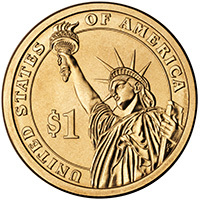The U.S. Treasury could save taxpayers more than $500 million a year by increasing the circulation of $1 coins, something it was authorized to do more than a decade ago, according to analysts at Citizens Against Government Waste, one of the nation’s leading taxpayer watchdog groups.
Thirteen years ago Congress passed the U.S. $1 Coin Act of 1997, giving the Treasury the authority to put $1 coins into circulation.
The Federal Reserve and the U.S. Mint are required by law to remove barriers to the $1 coin’s circulation. However, the Federal Reserve issues the United States’ paper currency and doesn’t like the competition from the $1 coin, which is issued by the U.S. Mint. The Fed’s leaders have instituted regulations and red tape that restrict access to $1 coins for banks, businesses, and individual Americans, says CAGW President Tom Schatz.
‘More Durable, Costs Less’
“The $1 coin [would save] the federal government considerable sums of money because $1 coins are more durable and cost significantly less to produce over their lifespan than $1 bills,” said Schatz. “Taxpayers deserve to realize the savings associated with these coins. It is time for Treasury Secretary Geithner to remove bureaucratic barriers and aggressively promote the circulation of $1 coins.”
Replacing the $1 bill with a coin would save taxpayers $522.2 million a year, according to an April 7, 2000 Government Accounting Office (GAO) report. The savings would likely be higher today.
Steve White, editor of RePlay magazine, a trade publication that covers the coin-operated machines industry, said the strategy for the $1 coin includes phasing out the $1 bill, but that idea has not taken hold.
‘Very Successful in Canada’
“There’s not a lot of support for eliminating the dollar bill, though there are success stories,” he said. “Canada has effectively eliminated its two lowest paper denominations and has been very successful with coins replacing them.”
He added, “There’s a theory that Ted Kennedy was way too powerful for the country to eliminate the dollar bill, because the only company that provides the paper for dollar bills is in Massachusetts.” Kennedy became a U.S. Senator for Massachusetts in 1962 and remained in the Senate until his death in 2009.
Greater Durability
Most of the cost savings associated with coins comes from their durability, according to the GAO. The Bureau of Engraving and Printing produces approximately 3.4 billion $1 bills each year. Each costs 4.2 cents to make and has a lifespan of approximately 21 months.
The $1 coin costs more to produce—12 to 20 cents—but has a lifespan of 30 years or more. The coins are also cheaper to handle and process. Mass transit agencies have found processing $1 coins costs 83 percent less than processing $1 bills.
Leslie K. Paige ([email protected]) is media director for Citizens Against Government Waste in Washington, DC.
Internet Info
“Financial Impact of Issuing the New $1 Coin,” United States General Accounting Office: http://www.budgetandtax-news.org/article/28225




